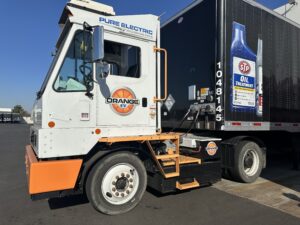
This 2021 Orange E-Triever VIN Verification was done by our team member in Ontario, Ca. on 09/26/2025.

This 2021 Orange E-Triever VIN Verification was done by our team member in Ontario, Ca. on 09/26/2025.
The 2021 Orange EV e‑Triever is a battery‑electric terminal tractor / yard truck designed for zero‑emissions operations in places like ports, rail yards, intermodals, and freight terminals. It is the continuation of Orange EV’s T‑Series, re‑branded in its third generation. It emphasizes high uptime, lower operating cost, and fleet usability.
Orange EV began deploying all‑electric yard trucks (the T‑Series) in 2015.
The model was rebranded/updated as the e‑Triever for model year 2022, though many of the specifications for the 2021 4×2 T‑Series carry over.
By 2021/2022, Orange EV had hundreds of its electric terminal tractors in operation and had accumulated substantial field data (miles, uptime) to support its designs.
It is fully electric; there is no internal combustion engine.
Motor: A brushless AC induction motor drives the vehicle via direct drive (i.e. no multi‑gear transmission).
Battery capacity choices: about 100 kWh or 180 kWh packs. Charging: Maximum charge rate is up to 70 kW.
Operational speed: Top speed is limited (yard/terminal use) at up to ~25 mph.
GCWR: Gross combined or gross vehicle‑combination weight rating around 81,000 lbs.
Cabin / Controls:
Digital truck systems (DTS) for cab architecture, improved sensing.
Remote diagnostics built in.
Optional IntelliBoom package: monitors 5th‑wheel load weight, boom lift cycles, kingpin presence & retention.
Build / Structure:
4×2 configuration (single rear drive‑axle) is standard for the yard/terminal version.
Construction tailored for heavy duty, repetitive starts/stops, high torque in low speed use.
Operational features:
Designed for up to 24 hours of shift operation on a single charge in many use cases.
High uptime: Orange EV reports ~98‑99% average uptime for its trucks.
Battery pack variants: 100 kWh vs 180 kWh. The larger pack gives longer operating hours and/or more frequent use.
Duty / configuration: The standard is a yard/terminal 4×2 layout. Variants may be built to customer‑spec in terms of fifith‑wheel setup, chassis length, and with optional packages like IntelliBoom.
Optional tech packages: as mentioned IntelliBoom; also remote diagnostics and sensing enhancements.
Safety features:
Because it’s low‑speed terminal work (≈25 mph), risks are different, but features include good sensing systems in cab, monitoring for kingpin, boom lift cycles, etc. (via optional IntelliBoom) to reduce accidents, mechanical failures.
Recall note: There is a recall covering 2017‑2024 T‑Series and 2023‑2024 e‑Triever for incorrect high voltage system lockout instructions in operator/maintenance manuals. The manuals incorrectly stated that the emergency stop button in the cab shuts off and locks out the high‑voltage system, which is not the case.
Technology:
Digital display / digital architecture in cab.
Remote diagnostics to monitor usage, maintenance, system health.
As a battery‑electric terminal tractor, “fuel economy” in the conventional sense doesn’t apply; instead, it’s about energy use and electricity cost.
Efficiency points:
Being electric, no tailpipe emissions. Zero diesel consumption.
High uptime (~98‑99%) means less downtime cost.
Payback: Some fleet users report 3‑ to 4‑year payback period compared to diesel equivalents, over a 10‑year life.
Range / duty cycle:
Up to 24 hours on a single charge in many typical terminal‑yard work environments.
Charging:
Up to 70 kW charge rate; time depends on battery size.
Competitors:
Other electric terminal tractors / yard dogs (Zero‐emissions depot/yard trucks) from companies like Motive, Kalmar, Terberg, Volta, etc.
Diesel yard tractors are the traditional competitors.
Key advantages:
Lower operating cost (electricity & fewer moving parts vs diesel).
Quiet operation, zero emissions, preferred for environmental compliance.
High uptime and smooth operation, reduced maintenance.
Potential drawbacks vs diesel:
Upfront cost tends to be higher.
Dependency on charging infrastructure in terminal / yard facilities.
If duty cycles exceed what battery capacity can support, can require battery swapping or charging downtime.
Positioning:
The e‑Triever is well suited for operations with regular short runs, repetitive yard moves, intermodal or rail yard operations where speed is not high but reliability, emissions, and operational cost matter.
I couldn’t locate a definitive MSRP for the 2021 Orange EV e‑Triever / T‑Series in the sources I checked. Public sources focus more on specs and operational costs rather than sales price.
However:
Fleets report that total cost of ownership (TCO) over time is favorable, with payback periods of 3‑4 years compared to diesel counterparts.
The warranty extension announced in 2025 (7.5 years / 30,000 hours) for battery, powertrain, and electric components helps reduce long‑term risk / cost.
While I didn’t find specific awards for the 2021 model, some recognition includes:
Positive media coverage for its high uptime, reliability, and operational cost benefits in fleet publications. Being among the leading providers (starting early in 2015) of electric yard‑terminal trucks, the brand has built a reputation for durability in that niche.